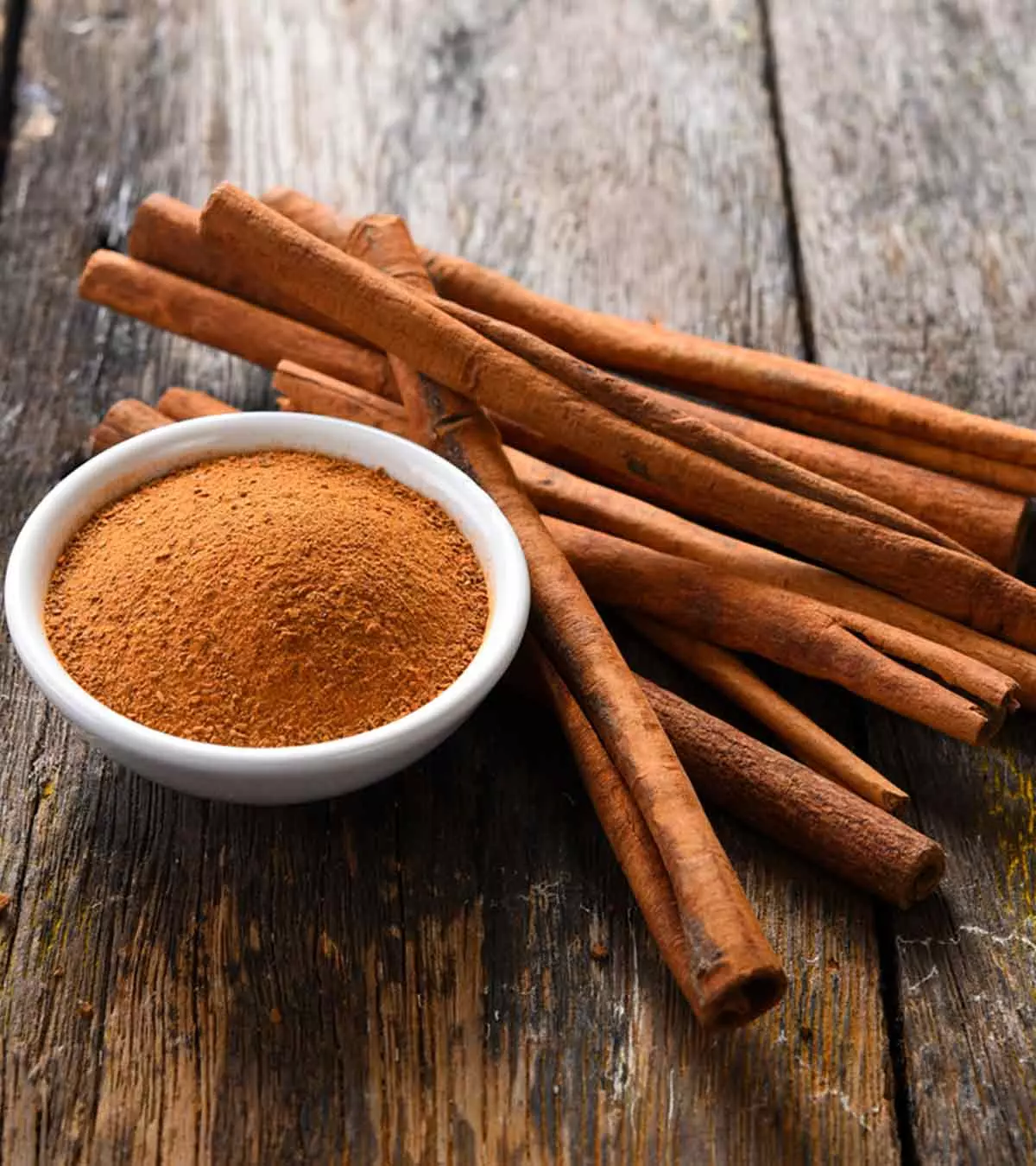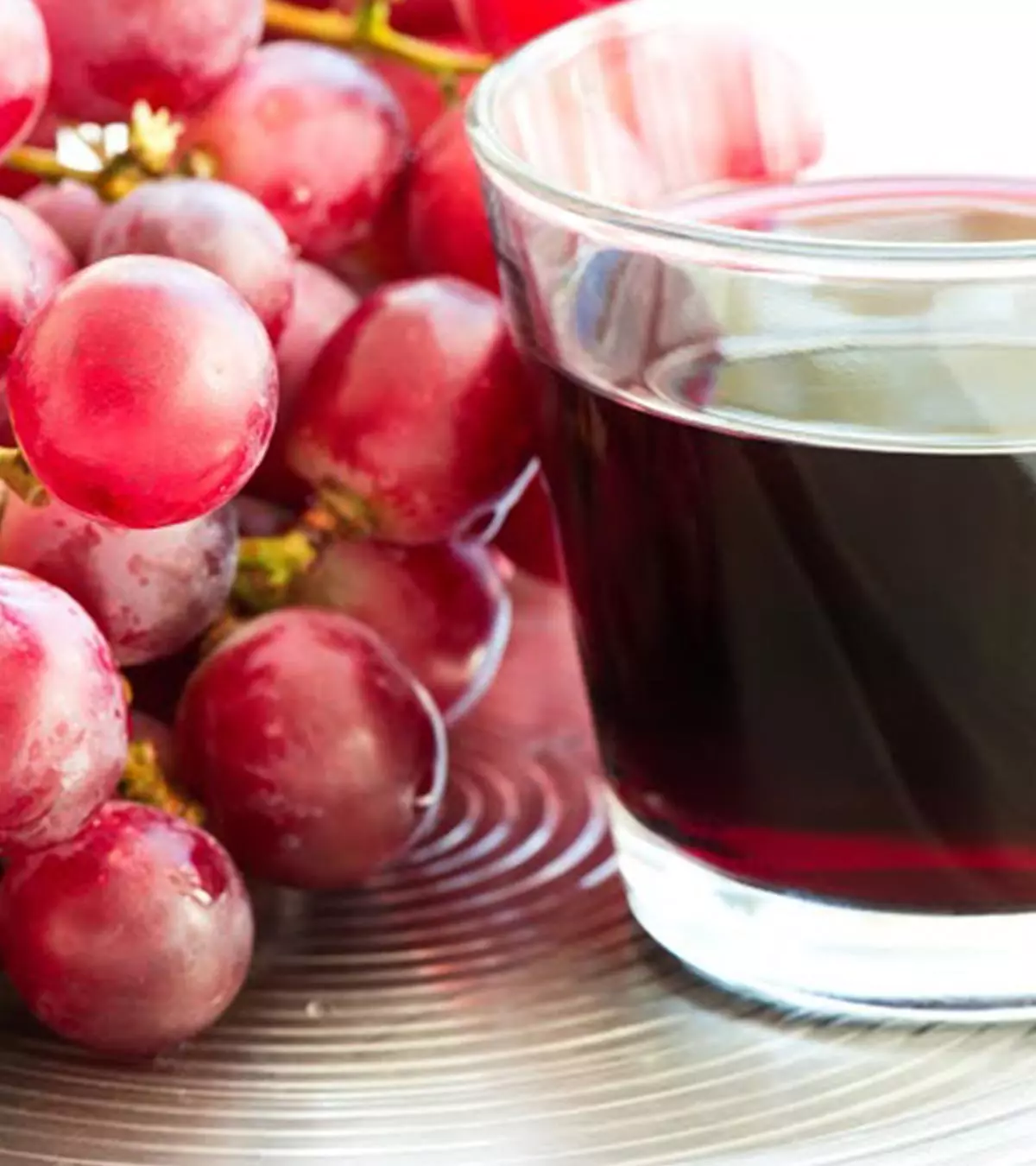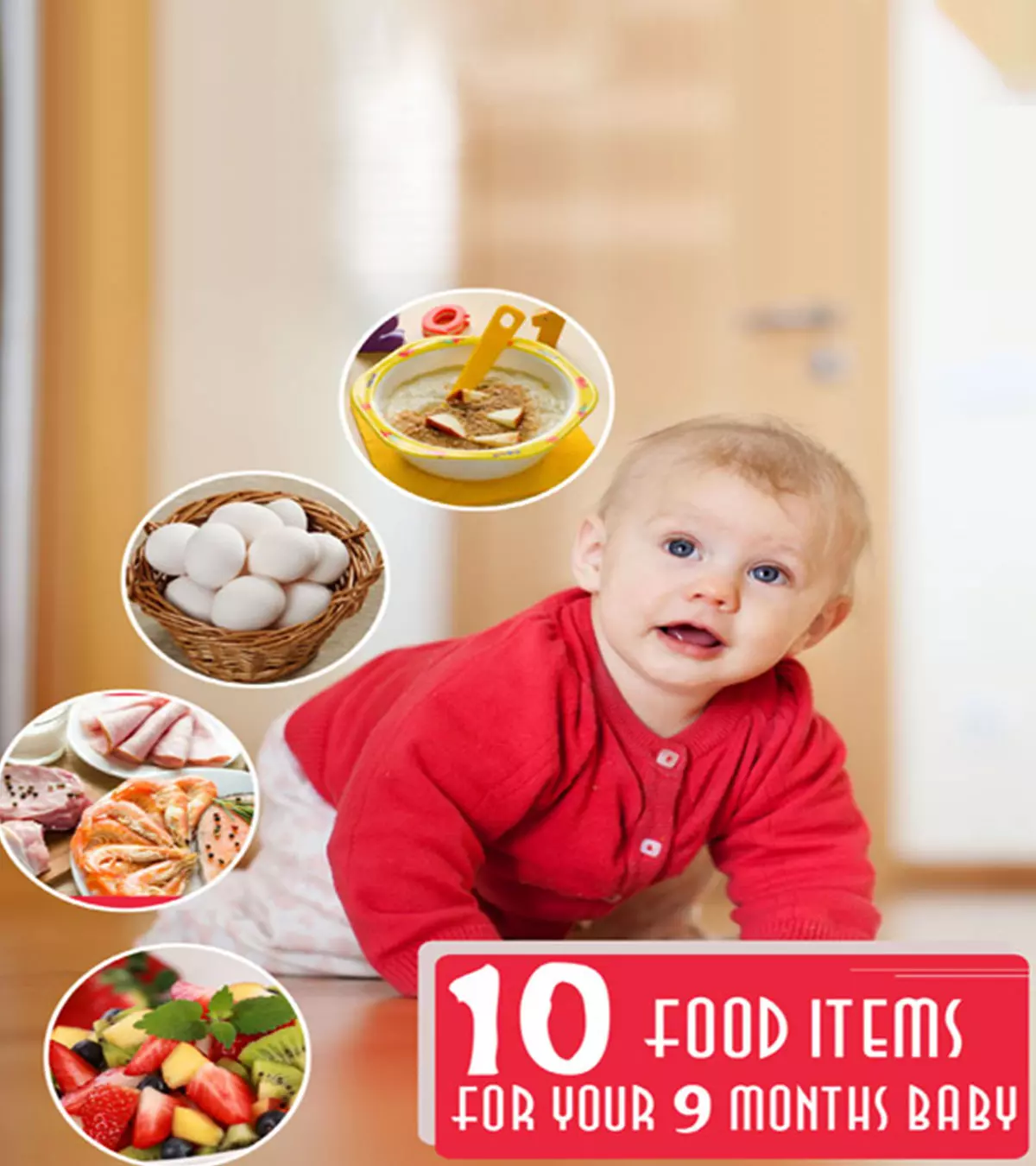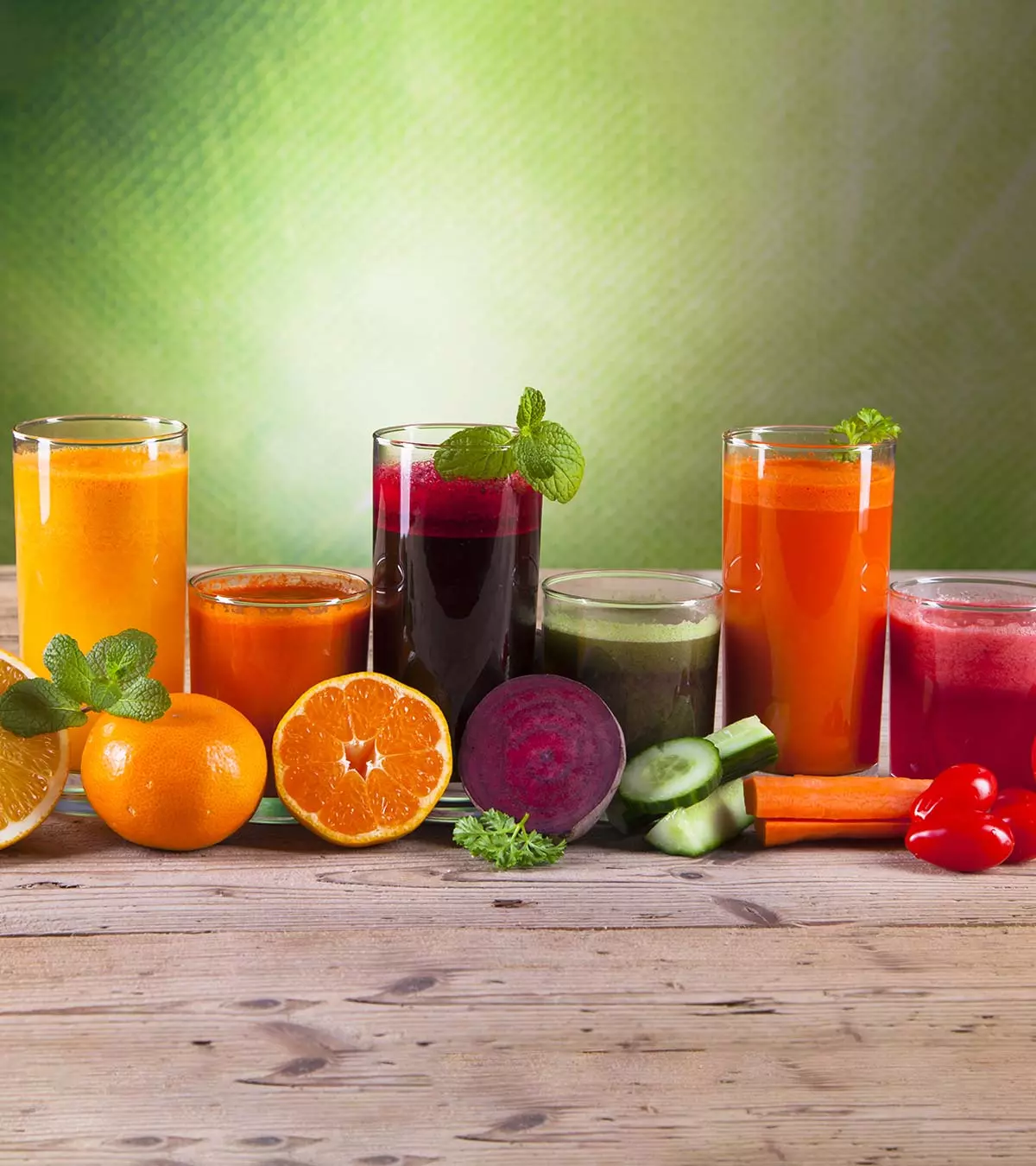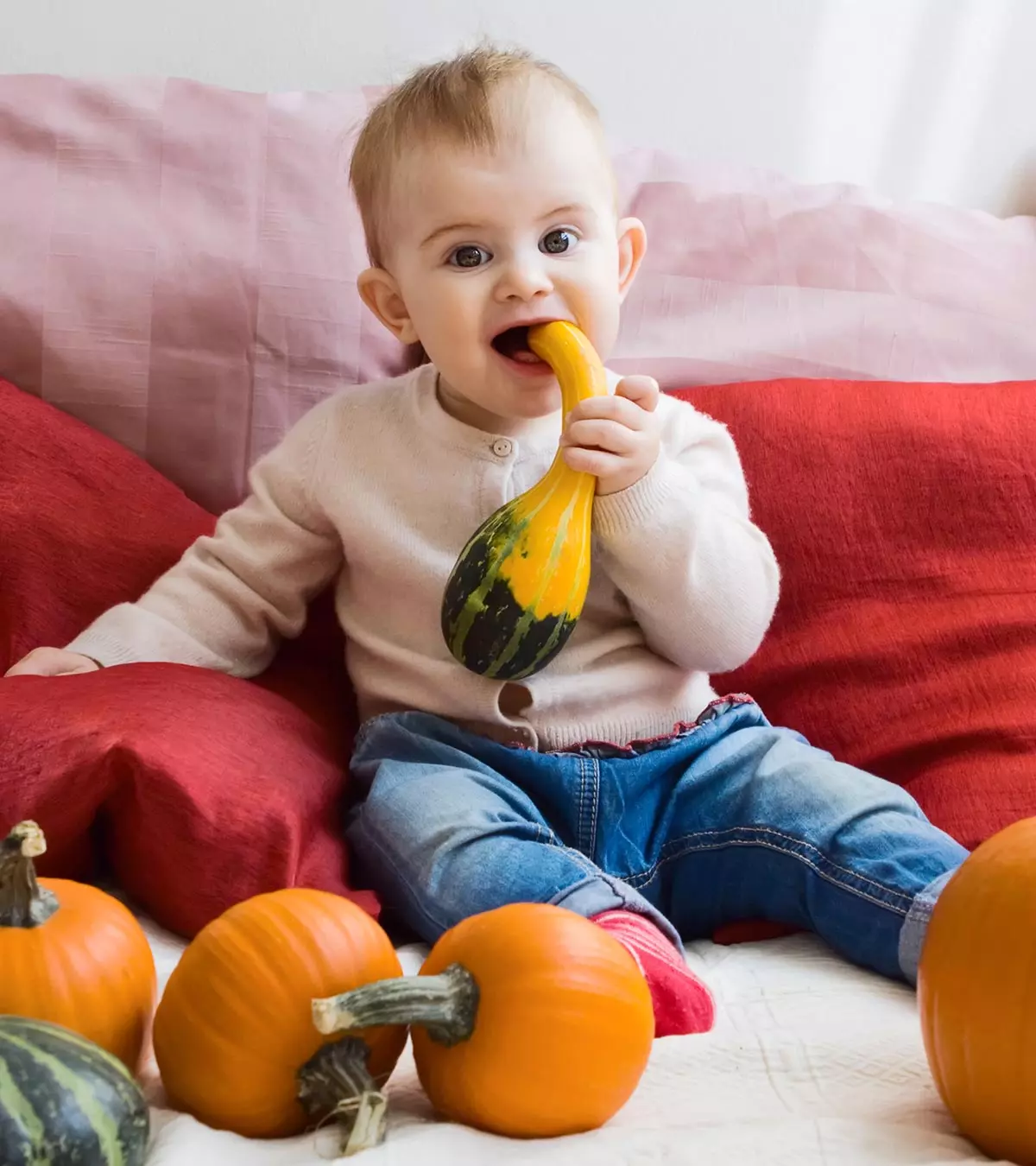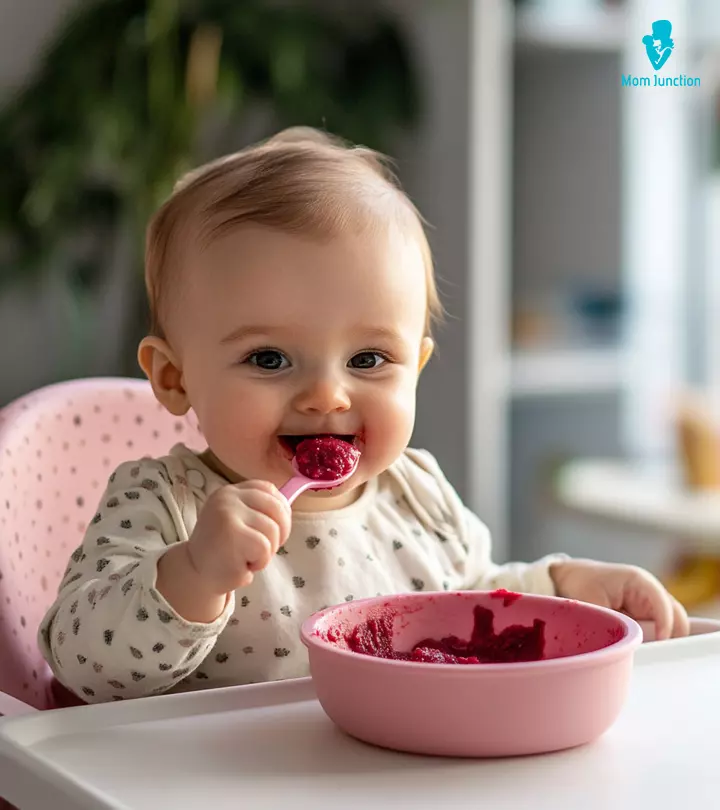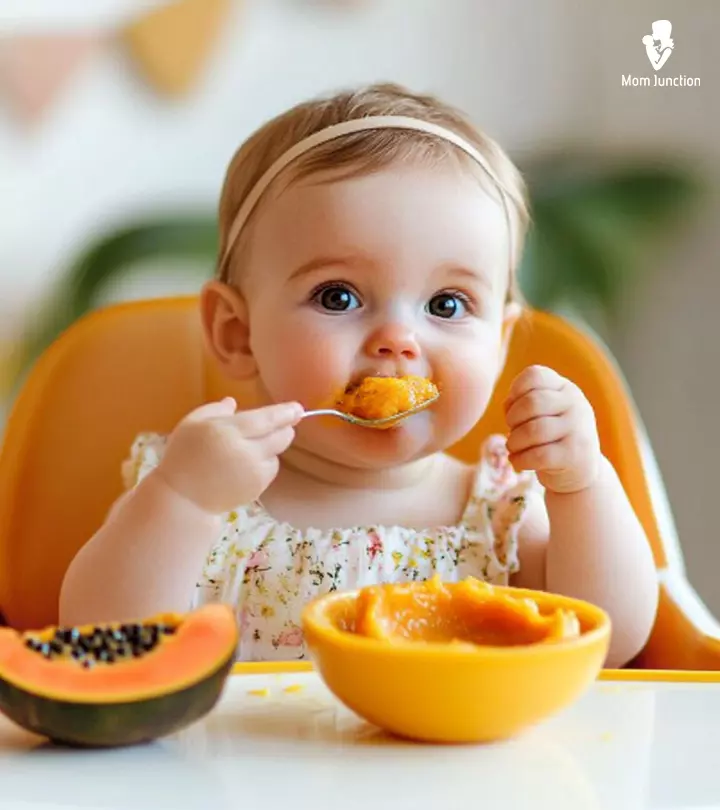
Image: Midjourney/ MomJunction Design Team
When your little one starts eating solid foods, you might also wonder if papaya for babies is a healthy option. Ripe papaya (Carica) is quite popular as a fruit for its soft texture and sweet flavor and has several essential nutritional and therapeutic characteristics (1). But, do the numerous advantages of this delectable fruit also apply to infants?

Continue reading this post for information on the safety of papaya for babies, its benefits, and precautions to take.
Key Pointers
- Papaya can be introduced into a baby’s diet between seven and eight months of age, under a doctor’s supervision.
- Papaya is a rich source of vitamins (A, B, C, folate) and minerals (calcium, magnesium, and potassium) and has antimicrobial and anthelmintic properties.
- Papaya might boost immunity and overall health, aid digestion, and wound healing.
- Excessive consumption of papaya can cause side effects in babies, such as allergies and stomach cramps.
- It is recommended to use fully ripe, thoroughly cleaned, and pureed papaya for baby food, and to follow the three-day rule to check for allergies and sensitivities.
Is Papaya Safe For Babies?
The US Food and Drug Administration considers papaya fruit as “generally recognized as safe (GRAS)” for infants (2). Thus, depending upon the age of your baby, you can serve papaya to the baby.
When Can Papaya Be Introduced To Babies?
Once your baby starts consuming solids with comfort, you can introduce papaya in your baby’s diet (3). Some pediatricians, in general, recommend introducing papaya to a baby around seven and eight months. However, you could start the fruit early, after introducing solids such as apple, banana, and potato. A few recipes that you might consider while introducing papaya to babies are papaya puree, papaya pudding, papaya pancake, and papaya smoothie.
While papaya is usually hypoallergeniciSomething that is less likely to cause allergic reactions. some cases of papaya allergy have been documented (2). Therefore, consult a pediatrician before introducing papaya to your baby.
Nutritional Value Of Papaya
Papaya is considered as one of the most nutrient-dense fruits ever known. It is a rich source of a potent form of vitamin-A, beta-carotene (4).
Below is the approximate composition of 100 grams of raw papaya with the recommended dietary allowance of nutrients for infants.
| Name | Amount | RDA |
|---|---|---|
| Water | 88.06g | – |
| Energy | 43Kcal | – |
| Fiber, total dietary | 1.7g | – |
| Sugars, total including NLEA | 7.82g | – |
| Calcium, Ca | 20mg | 210mg (0-6 months) 270mg (7-12 months) |
| Magnesium, Mg | 21mg | 30mg (0-6 months) 75mg (7-12 months) |
| Phosphorus, P | 10mg | 100mg (0-6 months) 275mg (7-12 months) |
| Potassium, K | 182mg | 500mg (0-6 months) 700mg (7-12 months) |
| Sodium, Na | 8mg | 120mg (0-6 months) 200mg (7-12 months) |
| Vitamin C | 60.9mg | 20mg |
| Folate, total | 37µg | 24µg (0-6 months) 32µg (7-12 months) |
| Choline, total | 6.1mg | – |
| Vitamin A, IU | 950IU | 1166 IU |
| Vitamin K | 2.6µg | – |
Sources:
U.S. Department of Agriculture (5) and World Health Organization (6)
Health Benefits Of Papaya For Babies
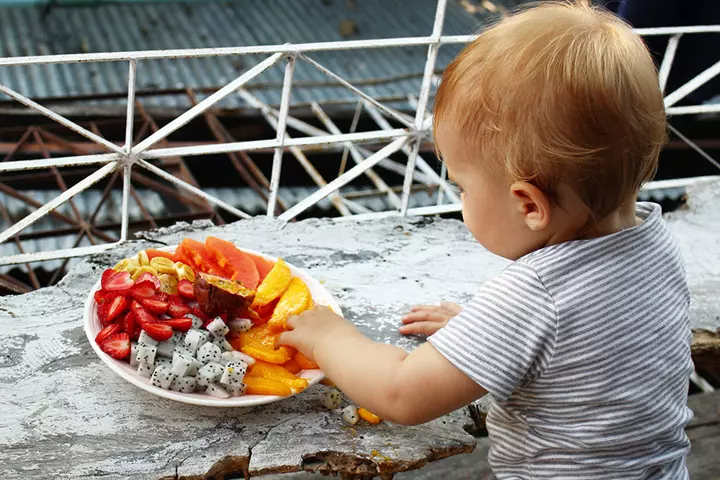
Papaya has some prominent benefits for babies, as mentioned below in detail.
- Could support immunity: Papaya is considered to have nutraceutical properties. These properties are believed to enhance immunity and improve the quality of life in terms of good health due to several digestive enzymes. The fruit contains considerable amounts of vitamin-A, B, C, and proteolytic enzymesiEnzymes that aid in the breakdown of food for energy and digestive function. like papain and chymopapain. These constituents are believed to provide antiviral, antifungal, and antibacterial properties to the fruit (7).
- Helps in digestion: In traditional medicine, papaya has been used as a remedy to treat digestive disorders. Papaya contains biologically active compounds such as papain, which is believed to help digestion (8). In addition, papaya has considerable amounts of water and fiber that could potentially help in maintaining digestive health by keeping constipation at bay.
 Quick fact
Quick fact- Supports healing: Papaya is believed to be helpful in healing wounds and sores. It has good amounts of vitamin-C and proteolytic enzyme, papain, which both aid in wound healing. A recent research study showed that topical application of papaya extract could possibly help in prompt wound healing (9).
- Works against intestinal worms: Papaya is considered as one of the oldest fruit antihelminticiSubstance that works against parasitic worms. plants (10). However, its effectiveness was mostly anecdotal until a few years ago. But now, much in-vitro clinical research shows that certain bioactive compounds in papaya could possibly help work against gastrointestinal worms (11).
- Supports body functions: Papaya is one of the foods with considerable amounts of dietary folate. Folate is crucial for babies, as it supports many biochemical functions that are necessary for growth, development, and sustenance. The most crucial functions that folate performs are – metabolism, brain development, and DNA-RNA synthesis (12) (13).
- Supports vision: Papaya is one of the rich sources of vitamin-A, which is a vital nutrient for growth and development. In particular, vitamin-A helps in vision development that is crucial during the early years of life (14). A research study has shown the effectiveness of vitamin-A derivatives in treating retinal degenerative diseasesiProgressive neurologic disorder affecting the retina of the eye. (15).
- Boosts overall health: Papaya has various vital nutrients with considerable amounts of antioxidants and biologically active compounds such as papain. It also has a lipidic composition that acts as an anti-inflammatory marker. The fruit also has considerable amounts of other micronutrients, such as potassium and phosphorus, which are beneficial for babies. The antioxidant and anti-inflammatory properties of papaya and its many nutrients make it a fruit worth including in your child’s diet (16).
Note:
All the nutrients available in papaya can support the growth and development of your baby. However, papaya cannot be a standalone food for your baby, especially after six months of age. Introduce a variety of fruits, vegetables, and other food groups in your baby’s diet to ensure optimum nutrition.
You must also practice caution while introducing papaya in your baby’s diet. This is important as, like any other food, papaya could have its side-effects.
Side Effects Of Papaya For Babies
The following are the probable side effects of papaya for babies.
- Allergy: IgE-mediated hypersensitivity via pollen inhalation and fruit consumption has been documented in the case of papaya (17). If your baby is allergic to latex, then papaya allergy is likely to happen (18). If your baby has a history of allergies or anyone in the family has a history of allergy, then pediatric consultation is wise before feeding papaya to your baby.
- Stomach ache or cramps: Unripe papaya is known to have high amounts of latex. Latex can potentially upset the stomach leading to stomach cramps and aches (19). The amount of latex is known to reduce as the fruit ripens. Therefore, it is important to serve only ripe papaya to babies.
, a pediatric and pregnancy dietitian from Liverpool, England, says, “Papaya is a fiber-rich fruit and is high in an enzyme called papain which supports digestive issues. However, I would not advise giving papaya to babies to support with relieving gas, as it is likely to cause negative effects on the gastrointestinal tract due to its high-fiber content.”
Following some precautionary steps could ensure the safe consumption of papaya for babies. So let’s check some of them in brief.
Precautions To Take While Serving Papaya To Babies
Depending upon the signs of readiness, you can start feeding papaya to the baby with the following precautions in mind (20) (3).
- Never introduce two new food items together, as the same creates confusion to determine which one is not suitable for your baby. Always follow a three to five days ‘wait and watch’ rule.
- While preparing any item with papaya, maintain hygiene as babies under two years of age are most vulnerable to infections. Therefore, wash and peel the fruit properly and remove any seeds or piths carefully.
- Select only ripe papaya as they are easy to digest.
- Start with the papaya fruit puree for babies. Ensure no lumps are there in the puree to avoid choking.

- Initially, feed only small amounts such as a teaspoon or two.
- As the baby grows, you can give papaya as finger food, and then you can mix it with other food items such as porridge to amplify the nutritive value of the diet as a whole.
 Quick tip
Quick tipAfter knowing the basics about papaya, it’s time to check some recipes that you might like to try for your baby.
Quick Papaya Recipes
As you plan to give papaya to your baby, refer to the age group of your baby and choose the best way to feed. Below are some age-specific homemade baby food recipes that you can try.
For Babies 4-6 months
Babies between the age of four to six months have a very vulnerable digestive system. Therefore, it is wise to introduce papaya to them in puree form. Below is a recipe for papaya puree that you may like to try.
Papaya puree

You will need:
- 1 cup peeled and chopped papaya
- Water
How to:
- Blend the peeled and chopped papaya pulp in a blender. Ensure that no seeds are there in it.
- If there are any lumps, then add ¼ cup of water and blend the mixture again.
- As you see a smooth paste, transfer that in a bowl.
- Serve fresh puree to your baby and store the left-over in a steel container. Do not use a puree if it is more than two days old. You can also add breastmilk or formula milk in the puree.
You can also incorporate other healthy food items to customize the puree recipe according to your baby’s preferences. Sharing a healthful addition to her baby’s diet, a mother and a blogger recounts how spinach and papaya puree helped her treat her baby Athyn’s low iron levels, “I was very worried to stop the iron drops knowing he (Athyn) has a low count (iron level) through blood work. So I made up my mind and ensured he gets greens in his everyday diet. I add at least a handful of spinach to his khichdi every day for lunch. But some days, that just won’t do. When more is needed, the puree form has to come in. Although Athyn is not a big fan of purees, this (spinach and papaya puree) one is a hit with him, possibly because of the sweetness Papaya brings in (i).”
For babies 6-8 months
As per WHO, you can feed half a cup of soft food two to three times a day to babies of six to eight months of age. Your baby can eat anything except honey and egg whites until the age of one year (21). So, now is the right time that you mix papaya with other foods to make a more wholesome recipe.
Papaya and blueberry yogurt

You will need:
- 1 cup peeled and chopped papaya
- ½ cup blueberry
- 1 cup whole milk yogurt
How to:
- Take a blender and put peeled and chopped papaya with thoroughly cleaned, de-skinned, and deseeded blueberry in it.
- Blend the mixture well. Ensure no lumps are formed.
- Now add yogurt to the mixture and blend the mixture once again until you get a smooth paste.
- Serve this delectable snack to your baby as an early evening snack.
Papaya oatmeal
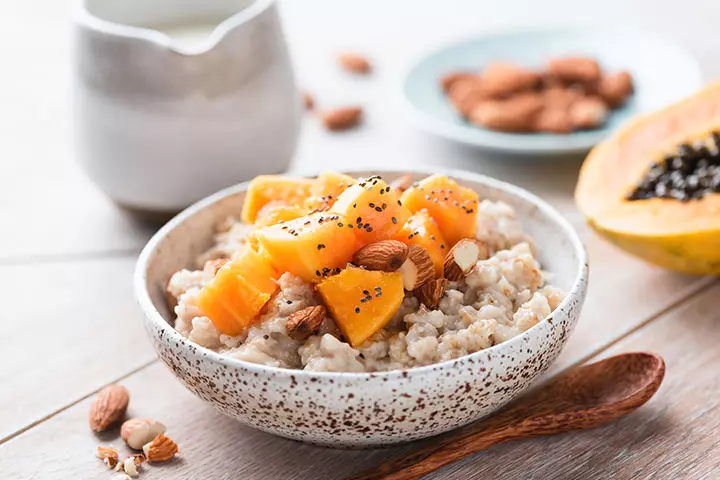
You will need:
- ¼ cup rolled oats
- 1½ cups water
- ½ tsp cardamom powder
- ½ cup ripe papaya puree
- 1 bay leaf
How to:
- Cook oats in water on low-medium heat to prepare a smooth, lump-free slurry.
- Add cardamom and bay leaf once the mixture begins boiling and cook for five minutes.
- Switch off the flame. Add the ripe papaya puree to the oatmeal and mix well.
- Serve warm. You may add half a teaspoon of dried fruits and nut powder to raise the recipe’s nutritional value.
For babies 9-12 months
As your baby reaches this age group, you can start feeding soft food into small pieces instead of mashing or blending them. It is likely that by this age, your baby might even start to eat food with fingers.
Papaya pancake

You will need:
- 1 ½ cups multigrain flour
- 2 tsp baking powder
- 2 tbsp brown sugar
- 1 tsp kosher salt
- 1 ½ cups whole milk
- 2 large eggs
- 1 tsp extract
- 2 medium papayas (peeled, seeded and diced)
- Pure maple syrup (optional)
- ½ cup chopped almonds (optional)
How to:
- In a bowl, add multigrain flour, sugar, salt, eggs, and baking powder. Whisk the mixture well and keep it aside.
- Now, take a blender and add chopped almonds and diced papaya in it. Blend them together until you get a smooth paste.
- Add the blended papaya and almond mix to the mixture prepared earlier. Whisk the entire mixture again and keep it aside.
- Take a flat pan and keep it on medium heat, pour the pancake batter. Cook for a minute and flip. Cook the other side for one minute too. You can see the sides turning brown, and that is an indication that pancakes are cooked.
- Serve hot pancakes with maple syrup.
Tip:
As you have added papaya to the mixture, chances are there that the pancakes might stick to the pan. In such a scenario, drizzle a few drops of oil on the pan before spreading the batter.
Papaya and spinach smoothie
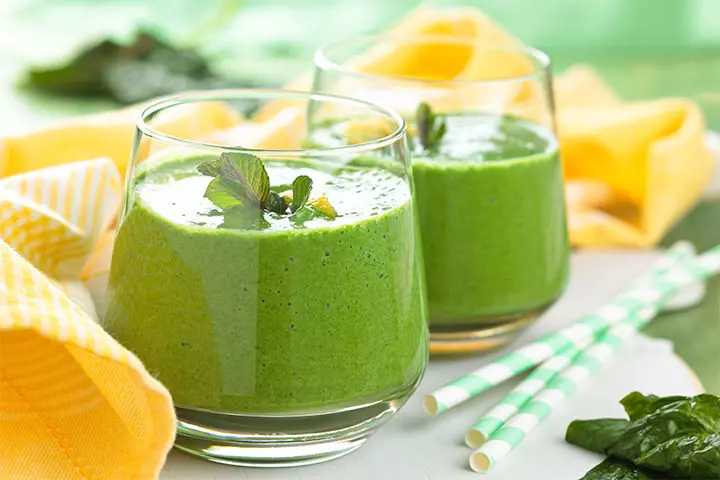
You will need:
- 10 spinach leaves (blanched)
- 1 cup ripe papaya cubes
- 1 cup unsweetened soy milk
- ½ cup unsweetened Greek yogurt
- 1 tsp dried fruits powder
How to:
- Blend all the ingredients using a blender or food processor into a smooth, lump-free fluid.
- Pour the smoothie into a cup with a wide-hole straw and serve. Alternatively, you can pour the smoothie into a bowl and let the baby eat it with a spoon.
- You can freeze the leftover smoothie and serve it to your baby as an ice pop.
 Quick tip
Quick tipRecipes involving papaya are countless; however, choose a recipe that meets the nutritional needs of your baby.
Frequently Asked Questions
1. Is papaya leaf juice safe for babies?
A few research studies have indicated the use of papaya leaf extract in babies but only for medical concerns such as dengue fever and thrombocytopenia. Its safety and efficacy as a herbal therapy to manage dengue and thrombocytopeniaiCondition characterized by low blood platelet count. are documented (22) (23).
However, consuming papaya leaf juice otherwise is not common, especially in babies. Therefore, consult your pediatrician if you are planning to give papaya leaf juice to your baby.
2. Can babies have papaya during fever?
Babies can have papaya during fever. It is a nutritious fruit that is easy to digest and can provide your baby with essential nutrients needed to support immunity.
3. Can a baby eat papaya and banana together?
Yes, you may give a baby banana and papaya together in puree form. There is no scientific advice against it.
4. How do you cut papaya for baby-led weaning?
Peel and deseed ripe papaya first. Then cut them into two inch finger-like strips. Sprinkle dry coconut powder or infant cereal if the strips are too slippery for your baby to hold.
5. How can I incorporate papaya into my baby’s diet?
Besides plain papaya puree, you can add papaya as smoothies or finger foods to your baby’s diet (for babies over six months). Occasionally, mix papaya with the baby’s cereal or combine it with other fruits to create a salad (for babies over 12 months). Furthermore, you can freeze papaya pulp and serve the chunks to teething babies.
Papaya for babies can be introduced when the baby begins to eat solid foods such as vegetables or fruit purees. Vitamin A and carotenoids are abundant in papaya, and it helps boost immunity and digestion in babies. It is also known to reduce intestinal worms in babies. You may introduce papaya in small quantities and look for allergies or stomach cramps. If there are any issues, avoid giving papaya to the baby. Papaya puree, blueberry yogurt, and papaya pancakes are some baby-friendly papaya recipes.
Infographic: Safety Advice When Giving Papaya To Babies
While eating papaya is a big no during pregnancy, babies can eat it when they start solids. However, there are some safety tips you should consider before feeding the fruit to your baby. Look at the infographic below to learn some precautions you should know when giving papaya to babies.
Some thing wrong with infographic shortcode. please verify shortcode syntax
Illustration: Amazing Health Benefits Of Papaya For Babies

Image: Stable Diffusion/MomJunction Design Team
Personal Experience: Source
MomJunction articles include first-hand experiences to provide you with better insights through real-life narratives. Here are the sources of personal accounts referenced in this article.
i. Spinach and papaya puree;https://babyfoodcenter.blogspot.com/2013/07/spinach-and-papaya-puree.html
References
1. Milind Parle and Gurditta, Basketful Benefits of Papaya; Researchgate
2. Papaya; National Center For Biotechnology Information
3. How to Make Homemade Baby Food; Eat Right; Academy of Nutrition and Dietetics
4. Go Tropical with Super Fruits; Eat Right; Academy of Nutrition and Dietetics
5. Papayas, raw, (SR LEGACY, 169926); Fooddata Central; USDA
6. Feeding and nutrition of infants and young children; WHO
7. Karunamoorthi Kaliyaperumal et al., Papaya: A Gifted Nutraceutical Plant – a Critical Review of Recent Human Health Research; Researchgate
8. Kadry Mohamed Sadek, Antioxidant And Immunostimulant Effect of Carica Papaya Linn. Aqueous Extract In Acrylamide Intoxicated Rats; National Center For Biotechnology Information (2012)
9. Rachmi Fanani Hakim et al., Effect of Carica papaya Extract toward Incised Wound Healing Process in Mice (Mus musculus) Clinically and Histologically; Hindawi
10. Jerzy M Behnke et al., Developing novel anthelmintics from plant cysteine proteinases; National Center For Biotechnology Information (2008)
11. Dayane Moraes et al., In vitro efficacy of latex and purified papain from Carica papaya against Strongyloides venezuelensis eggs and larvae; National Center For Biotechnology Information (2017)
12. Lubna Mahmood, The metabolic processes of folic acid and Vitamin B12 deficiency; Journal of Health Research and Review In Developing Countries
13. Folate; National Institute of Health; U.S Department of Health and Human Services
14. Vitamin A; FAO
15. Lindsay Perusek and Tadao Maeda, Vitamin A Derivatives as Treatment Options for Retinal Degenerative Diseases; National Center For Biotechnology Information (2013)
16. Lidiani F. Santana et al., Nutraceutical Potential of Carica papaya in Metabolic Syndrome; National Center For Biotechnology Information (2019)
17. Moumita B. Sarkar et al., Cari p 1, a Novel Polygalacturonase Allergen From Papaya Acting as Respiratory and Food Sensitizer; National Center For Biotechnology Information (2018)
18. Latex Allergy; American College of Allergy, Asthma & Immunology
19. G et al., Traditional and Medicinal Uses of Carica papaya; Journal of Medicinal Plant Studies (2013)
20. Tips to Keep Your Child Healthy; Healthy Children; American Academy of Nutrition
21. Feeding your baby: 6–12 months; UNICEF
22. Chandra Prakash Kala; Leaf Juice of Carica papaya L.: A Remedy of Dengue Fever; Medicinal And Aromatic Plants
23. Aakash Pandita et al., Use of papaya leaf extract in neonatal thrombocytopenia; Wiley Online Library
24. Papain: Nature’s Own Digestive Aid; Winchester Hospital
Community Experiences
Join the conversation and become a part of our nurturing community! Share your stories, experiences, and insights to connect with fellow parents.
Read full bio of Sumaiya Patankar
- Hannah Whittaker is an expert pregnancy and pediatric dietitian with nearly 20 years of experience, the last seven years as a registered dietitian. She manages her private practice Bump2baby Nutrition in the UK, having done her graduation in community nutrition and dietetics from Liverpool John Moores University & University of Chester respectively.
 Hannah Whittaker is an expert pregnancy and pediatric dietitian with nearly 20 years of experience, the last seven years as a registered dietitian. She manages her private practice Bump2baby Nutrition in the UK, having done her graduation in community nutrition and dietetics from Liverpool John Moores University & University of Chester respectively.
Hannah Whittaker is an expert pregnancy and pediatric dietitian with nearly 20 years of experience, the last seven years as a registered dietitian. She manages her private practice Bump2baby Nutrition in the UK, having done her graduation in community nutrition and dietetics from Liverpool John Moores University & University of Chester respectively.
Read full bio of Swati Patwal
Read full bio of Rohit Garoo
Read full bio of Ghazia Shah







